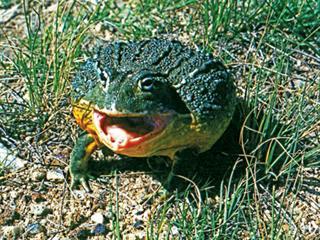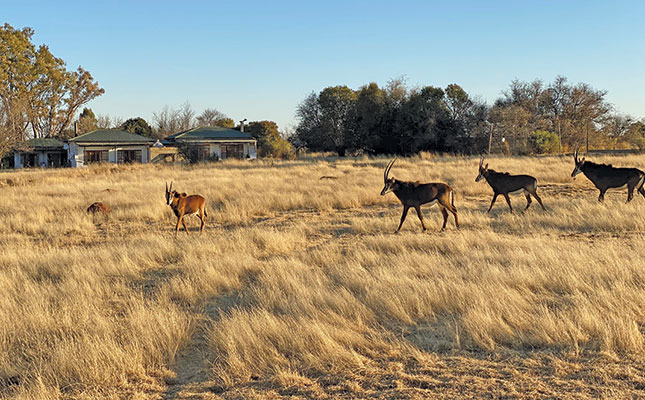
I was lying flat on my stomach on grass still wet from last night’s heavy rain, with a notebook in one hand and a camera in the other. I was watching frogs – giant bullfrogs in fact. Before me a bizarre scene of amphibian savagery was unfolding. Huge male bullfrogs were jostling each other for the few prime spots in the long grass where the water of the vlei had spilled over into the veld.
The air was reverberating with their deep booming calls, while they continually launched at each other with their huge mouths agape. Unlike most other frogs, their powerful jaws are well-armed with teeth, the lower jaw with two big, tooth-like bony projections that can inflict serious damage.
After a day or two of these non-stop battles, the smaller females would arrive and the serious breeding action – extraordinary in the extreme – would start. Suffice to say that just about everything about the breeding behaviour of the African bullfrog (Pyxicephalus adspersus) is exceptional.
Although it is our largest frog, it breeds in the shallowest water and develops from egg to frog in a fortnight. It is a devoted cannibal, but the tadpoles eat grass and breathe with oversized lungs instead of gills. It is said that the adult male guards the tadpoles and attacks anything that comes close to them. This is all true, except for the males guarding the tadpoles, as research I have done shows something quite different.
Where it all began
As far as I know, over 40 years ago (1969), I was the first person to start a detailed study of the ecology of the African giant bullfrog, and although the study was never completed, I spent weeks in the field with them and made some fascinating observations. One observation concerns the popular view that the male bullfrog does paternal (fatherly) duty by guarding and protecting the young tadpoles.
This has been reported in scientific literature and shown on the National Geographic television channel. What I recorded, however, was quite different. I found that one or two large males sometimes returned to the breeding site about a week after egg laying, when the swarming tadpoles were about halfway through their metamorphosis, and remained with them day and night.
But to my initial surprise I saw, and confirmed this on numerous occasions, that when the tadpoles moved into such shallow water that their backs protruded above the surface, the male would move in and gobble them up by the mouthful. The reason for their extreme aggression during this time is open to speculation, but it could be due to protecting a food source.
Because bullfrogs were extremely plentiful in those days, I caught a few, killed them with chloroform in an airtight container, and dissected them. Their stomachs were invariably tightly packed with half-digested tadpoles. To this day I have a specimen jar with tadpole remains in formalin, from one of these supposed ‘green guardians’.
Nature’s guardians
This brings me to another supposed guardian situation. It is generally assumed that if you are a nature conservator or game ranger you will be an incorruptible guardian of nature. You will be so dedicated to your mission of protecting the environment as well as the plant and animal life in your care that nothing else will matter to you.
In the words of Dr Ian Player, the undisputed doyen of game rangers in this country: “A ranger must be absolutely disciplined, totally trustworthy, very loyal and should be unflinching in the cause of conserving nature in all its facets.”
It is as if the green uniform and epaulettes on your shoulders will transform you into a divine green-winged angel incapable of any wrongdoing. As if, with you on guard, everyone can sleep peacefully knowing that our natural heritage will be inviolable. This is unfortunately a fallacy.
Where are our guardians?
Although the majority of game rangers and field-based conservationists are dedicated, they have the same needs and desires and are subjected to the same temptations as others. Because they know the importance of their work to protect our natural heritage, they are willing to work long hours when others play, and sacrifice many of the luxuries we take for granted.
With rare exceptions they are, however, always underpaid, but unlike other workers, it is very uncharacteristic for them ever to go on strike. It takes a very special kind of individual to be worthy of those green epaulettes. In the real world, however, this is not always the case.
The recent strike by 361 staff members – of which 248 were rangers – in the Kruger National Park at a time when the park was engaged in the fiercest rhino war in its history, is ample proof of that. This means that 50% of the entire ranger corps had abandoned their posts in a dispute about money. To me this is a disturbing indication that either the wrong kind of people are employed, or that there are serious internal problems in SANParks, or both.
It had repeatedly been announced that an additional 150 rangers would be recruited and would soon be deployed to bring the number of rangers to the awesome figure of ‘over 650’. This according to SANParks head of communications Wanda Mkutshulwa, who said she was not at liberty to divulge how many police and defence force members were additionally deployed to assist them.
With such a taskforce, how can more than half the rhino slaughters take place there? When I enquired about the training of the new recruits, she said it would take only “a few weeks”.
Irregular activities
Then, hot on the heels of the strike and while it was still ongoing, a report appeared in the Mail & Guardian on 17 February 2012, alleging that massive irregularities, corrupt and simply criminal activities are the order of the day at SANParks and in the Kruger Park.
It would also help your understanding to read about the salaries that are offered to game rangers, to those who are supposed to be the custodians of our rhinos and other precious wildlife. You’ll be amazed. How can you give a man, carrying such responsibility, only a crash-course in conservation, then pay him a meagre monthly salary and expect a dedicated game ranger? (In an interview, a spokesman for the strikers claimed that some earn only R2 100 a month).
It’s across the board – not only at SANParks, but also at the big five lodges. This is hardly enough to live on, let alone to inspire people with passion, loyalty, honesty, reliability and a superior work ethic for this demanding and highly dangerous job. It doesn’t take an Einstein to figure out what to expect when you put a rifle and panga in their hands and send them into temptation where one or two pulls of the trigger can make them very, very wealthy?
And it’s not that it doesn’t happen. From time to time, revelations of conservation staff involvement in poaching surface. The public requires answers. It requires that government starts a high-level, independent investigation so we will know whether our vulnerable tadpoles are guarded by a big green frog – or even a crocodile.
Contact Abré J Steyn on 083 235 4822 or at [email protected], with ‘Field Sports’ in the subject line.













